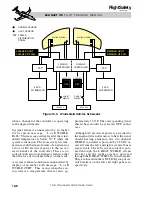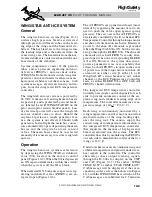
PITOT-STATIC AND STALL
WARNING ANTI-ICE SYSTEMS
Anti-ice protection for the left and right main
pitot-static probes, the standby pitot-static
probe, the left and right AOA vanes, and the total
air temperature probe (TAT) is accomplished
by applying 28 VDC to integral heating ele-
ments within each component (Figure 10-8).
Pitot-static, stall warning and TAT probe anti-
ice protection is divided into two systems,
left and right, which are controlled with the
L PROBES and R PROBES switches located
on the anti-ice control panel (Figure 10-2,
page 10-3). They are S/I (switch/indicator)
type switches that display OFF captions when
the switches are turned off. Additionally,
when the probe switches are selected to OFF,
amber “L R PITOT HT” and “STBY PITOT
HT” CAS messages are displayed. When the
switches are selected ON, the S/I is blank (no
OFF annunciation) and all probe related CAS
messages are extinguished if the system is
working properly.
All heating elements can be activated on the
ground except the total air temperature (TAT)
probe which must receive an air mode signal
from the right squat switch system to acti-
vate. The TAT probe heat can be checked on
the ground by pulling the R SQUAT circuit
breaker located in the GEAR/HYD group and
turning on the R PROBES switch.
Table 10-2 shows the components that are
heated when the probes switches are turned ON.
All of the probes receive 28 VDC for anti-
icing from either the left or right main bus, ex-
cept the standby pitot-static heat which
receives power from the right essential bus.
With a single generator failure, all of the
probes elements remain operative. But, with
dual generator failure, the main buses are au-
tomatically shed and only the standby pitot-
static heat remains powered. However, if
necessary, one or both main buses can be re-
selected on the electrical control panel.
Tu r n i n g t h e L P RO B E S a n d R P RO B E S
switches on causes elements in the compo-
nents listed in Table 10-2 to be energized for
anti-icing. If current flow is below an ac-
ceptable level in any one of the components,
a corresponding CAS message is displayed
(Table 10-2). When a probes related CAS mes-
sage is displayed, flight manual corrective
procedures include checking the PROBES
switches on and checking the corresponding
circuit breaker (Table 10-2).
If it is determined that pitot-static heat fail-
ure is causing an airspeed, altitude, or verti-
cal speed error, selecting ADC reversion may
restore valid air data.
10-13
FOR TRAINING PURPOSES ONLY
L E A R J E T 4 5
P I L O T T R A I N I N G M A N U A L
FlightSafety
international
SWITCH
COMPONENT
CAS MESSAGE
CIRCUIT BREAKER
POWER SOURCE
Left Pitot-Static Probe
Left AOA Vane
Right Pitot-Static Probe
Right AOA Vane
TAT Probe **
Stby Pitot-Heat Probe
LEFT
PROBES
RIGHT
PROBES
L PITOT HEAT*
L AOA HT FAIL
R PITOT HT*
R AOA HT FAIL
SAT HT FAIL
STBY PITOT HT*
L PROBES HT PITOT
L PROBES HT AOA
R PROBES HT PITOT
R PROBES HT AOA
R PROBES HT SAT
R PROBES HT STBY PITOT
Left Main
Left Main
Right Main
Right Main
Right Main
Right Essential
* CAS message displayed when probes switch is OFF or system failed.
** The TAT (Total Air Temperature) probe is only heated when airborne.
NOTE: Although the TAT probe is technically measuring total air temperature, the associated CAS message and circuit
breaker use the abbreviation "SAT" (static air temperature).
Table 10-2. PROBES HEAT SUMMARY













































